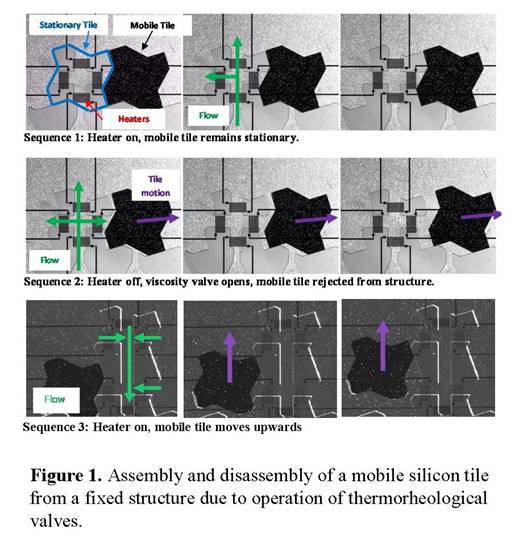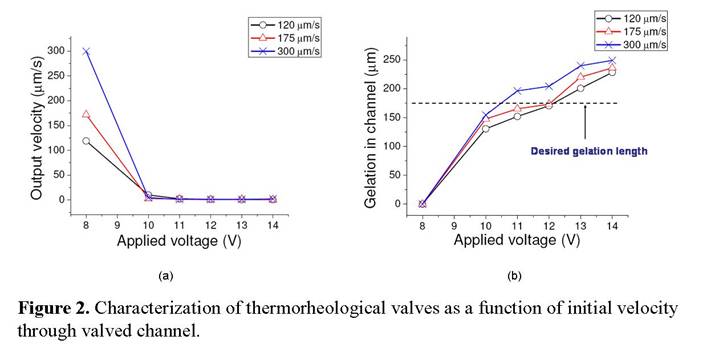485e Dynamically Tunable Affinities for Fluidic Self Assembly
Programmable matter refers to a novel functional form of matter where fundamental building blocks are assembled selectively in a dynamically-programmable assembly process to construct arbitrary target structures. This manufacturing paradigm offers an alternative to top-down direct fabrication methods and to static bottom up self assembly methods. In contrast to most current self assembly approaches which are static in nature, our assembly process is based on dynamically tunable affinities between assembling components (tiles) which facilitates the manufacture of irregular structures and allows for error correction.
Here we extend our previous work on fluidic self assembly [1] to include dynamic affinity switching between tiles using on-tile thermorheological valves which manipulate the local flow field within the tile. The valves are made up of an aqueous solution of a poly(ethylene oxide)x – poly(propylene oxide)y – poly (ethylene oxide)x triblock copolymer [2,3] that undergoes reversible sol-gel transition on heating. These valves can be used to manipulate the location of the attraction basin around the tile controlling where the next tile attaches to the main structure. These valves have the advantage, compared to valves based on soft lithography and MEMS type devices, of minimal tile level fabrication and do not fatigue with time. Additionally, thermorheological valves also have advantages over valves exploiting electrorheological effects in terms of significantly lower operating voltages.
In order to demonstrate dynamic affinity switching, we have patterned a “fixed tile” of PDMS with channels through it in a microfluidic chamber and a “mobile tile” made of silicon. The assembly chamber is provided with platinum heaters to open and close the thermorheological valves. The valves have been used to locally attract and repel a silicon tile and have been characterized based on applied voltage as shown in Figures 1 and 2. We have also carried out three dimensional numerical simulations to characterize the system based on the flow velocity through the valves and heater power.
References
[1] M. T. Tolley, M. Krishnan, D. Erickson, H. Lipson (2008), “Deterministic Non-regular Microstructures from Regular Components,” Proceedings of the National Academy of Sciences, submitted.
[2] G. Wanka, H. Hoffmann and W. Ulbricht (1994), “Phase-Diagrams and Aggregation Behavior of Poly(Oxyethylene)-Poly(Oxypropylene)-Poly(Oxyethylene) Triblock Copolymers in Aqueous-Solutions,” Macromolecules, 27, pp. 4145-4159.
[3] B. Stoeber, Z. H. Yang, D. Liepmann and S. J. Muller (2005), “Flow control in microdevices using thermally responsive triblock copolymers,” Journal of Microelectromechanical Systems, 14, pp. 207-213.

